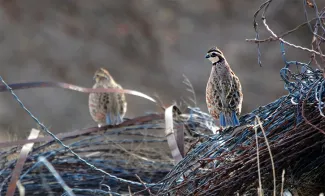
Provided by Oklahoma Cooperative Fish and Wildlife Research Unit, Oklahoma State University
The quail research project is beginning to wrap up.
Quail trapping continued through Dec. 12, with the last GPS transmitter being deployed on Beaver River Wildlife Management Area.
During the first 10 days of December, four transmitters were deployed at Beaver River. Six downed transmitters were recovered: three from Beaver River and three from Packsaddle WMA. No clear mortality signs could be identified for three of the recovered transmitters, while two showed signs of avian predation, and one was attributed to a winter storm in early December.
During December, 13 GPS transmitters were active across two of the four WMAs, with 10 deployed at Beaver River and 3 at Packsaddle. There were no active transmitters at Cross Timbers or Sandy Sanders WMAs during December.
In total, 64,876 individual locations have been collected since the launch of the first transmitter in May 2018. The monitoring of wildlife use with wildlife cameras on the research plots at each of the four WMAs was concluded during December. Analyses of bird survey data and vegetation data, as well as movement data from the GPS transmitters, continued during December.
INVERTEBRATE STUDY: Jacob Reeves was able to travel to Packsaddle WMA to begin setting up for field work between snowstorms in December. He set up plots in which to collect seeds in three large north-to-south transects that will be used to measure seed abundance and for covey call sampling. He also set up routes for vehicle line-transect surveys to observe raptors. The plan is to test for relationships between seed abundance, covey calls, and observations of raptors.
He completed several practice surveys of raptors during morning, midday, and late afternoon. Most frequently observed raptors were red-tailed hawks and northern harriers, as well as one great-horned owl in the late afternoon. During the course of his work, he observed multiple bobwhite coveys, and some of the birds posed long enough for a picture (see above). Reeves planned to return to Packsaddle WMA for a large part of January to conduct field work.
* * *
(This project is funded in part by the Oklahoma Department of Wildlife Conservation, Federal Aid Project F18AF001-10: Quail Ecology and Management II.)